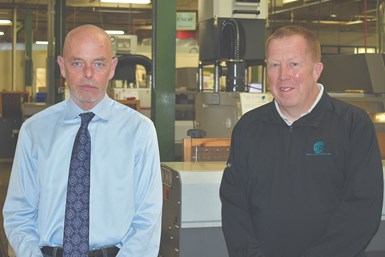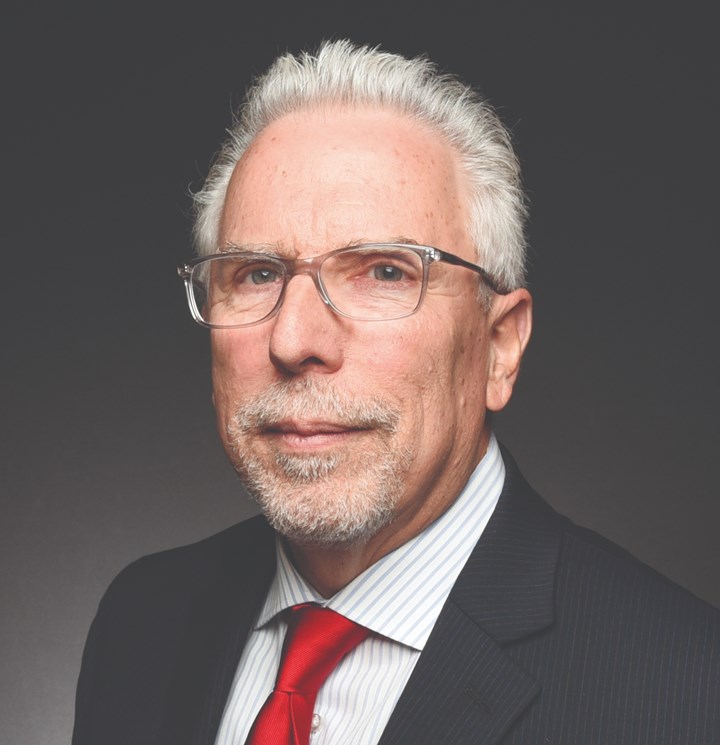Smith & Richardson — 100 Years of Mastering Change
Miles Free III interviews Smith & Richardson’s co-owners Rich Hoster and Phil Cowen to discover the secret to 100 years of success.

Phil Cowen (left) and Rich Hoster (right).
When Smith & Richardson’s president, Rich Hoster, was in engineering school, he learned all about the math involving “Delta” (∆) the symbol for “change” or the “gap.” Little did he know that when his career took him into management, he would have to help his team and himself manage this ever-present challenge. Smith & Richardson formed in 1921 — the year of the first radio broadcast baseball game and the year that Warren G. Harding was inaugurated our 29th president. During those 100 years, they have successfully managed many significant changes, including the loss of their original chaplet markets in North America, walking away from legacy cam technology, loss of major automotive markets in the great recession and creating a subsidiary overseas. Yet, Smith & Richardson — now a global company — and their people continue to thrive.
“Without our people, we have no business,” Rich says at the beginning of the interview. “Our people are part of our success.” This strongly held belief is reflected in their corporate motto, “Part of your success,” as they see their employees as just as important to success as their customers. Rich elaborates, “Dr. Sarah Cowen, an educator as well as an early owner, set our culture. She said that we are going to educate people. We are going to invest in our people, because people are the only reason that we have a business. Without people, we will have no business, and no future.”
“And that has proven to be true,” Rich continues, “When we pivoted out of cam machines to CNC technologies, it was our people that made this transition happen. Smith & Richardson had been operating a fleet of cam single-spindle Brown and Sharpe machines, many of which served automotive OEMs. Today, we are down to a single cam machine, and we have moved to a more profitable business than the automotive commodity parts that had been a staple.”
“Without our people, we have no business. Our people are part of our success.” - Rich Hoster
But moving from cam automatics to CNC equipment is just one of a series of major Deltas that the Smith & Richardson team have successfully navigated. Originally a producer of chaplets — essential hardware for the metal casting industry — Smith & Richardson saw the metal casting business move overseas. The chaplets were critical for the automotive sector, but 2008 proved that to no longer be a sustainable business. Smith & Richardson is the last chaplet producer in the United States, and has a plant providing chaplets, chills and core hardware in Taicang, China, for the Chinese metal casting industry. In an increasingly global and interconnected world, Smith & Richardson has managed to go from local supplier in a single national market to a global source of a wide variety of tight tolerance, precision machined, stamped, EDM, wire-formed parts that are essential for today’s advanced technology applications.
Phil Cowen, Rich’s partner and CEO, emphasized the differences needed as the company transitioned from having a product line of chaplets to order — and what is required to be a job shop — to selling capabilities and time on machines. According to Phil, “One of the keys to managing change — all of those Deltas we have and continue to face — has been a solid handle on our finances. Our culture is to invest in our people. To invest in our technology. You need to be on top of your financials if you are going to be able to make those investments effectively.”
Culture and Workforce
Workforce is a current challenge for the industry, but Smith & Richardson is blessed with the talent it has. As Phil explains, “Probably a little over 30% of our current workforce speaks another language at home. There is no way we could be thriving and being part of our customer’s success without them. We invested in English as a Second Language (ESL) classes to help them on the job and, at the same time, provided conversational Spanish classes to our managers and leaders, to try to close that gap. We need everyone’s talents and we continue to invest to help develop them. We pay 90% of our team members’ education expenses. It’s an investment.”
Phil Cowen explains it this way, “We are extremely proud of the people that we have worked with over the years and that we work with today. We have had good impact because of our good people. We have good products. And, to be honest, we have also had some good luck. But the ability to learn — all of us, not just employees, but us as leaders — this is key. This is probably the secret to our 100 years. We value and invest in learning.”
When asked if they are afraid the investment in training for their employees could walk away, Rich pivots to explain their culture. “We lost some of our 40-year plus employees recently as they have earned their retirements, and that has lowered our average team member’s time at Smith & Richardson to around 15 years. That shows that people find a career here. When we make business decisions — actually, let me be perfectly clear — when I have to make business decisions, the very first thing that I think about is the 50-plus families that will be impacted by what we decide.”
Rich continues, “We use an outside service to help us survey our culture. When we started this, we found another Delta — the gap between how we thought we were doing and what our team thought. It was unexpected. But assessing the culture regularly has helped us to close that gap, improve our communications and create closer alignment. “
Rich explains, “The culture piece is really a key. I am responsible for more in this business than just me. During COVID-19 we were deemed essential manufacturers — thanks to the help of PMPA, The Franklin Partnership, Illinois Manufacturing Association (IMA) and others here locally. So, during COVID-19, we were making parts for ventilators and other critical medical products. We came in to work one morning, and our neighbors put up this sign thanking us for our essential manufacturing work making parts for ventilators. Business is about finance, sure. But, more importantly, it’s about doing things for and with people. Culture is critical, and our people found out how essential a part of the world’s success they are.”
Quality Systems
Quality systems and OEM requirements were another Delta that Smith & Richardson met and then turned into a strength. Documented systems include policies, procedures and work instructions. Phil Cowen attributes their success in these areas to the formality that his mother, Dr. Sarah Cowen, instilled into Smith & Richardson with formal job descriptions to improve accountability.
Smith & Richardson is ISO 9001:2015 certified, and so has a host of systems for calibration and Gage R&R, Corrective and Preventive Action documentation, living control plans and even uses its internal and external quality performance as an input to team member compensation. “It aligns our performers with the interests of the customer and the company — all of us that have a stake in the business.”
When asked how it was that fear didn’t derail their plans or their team, Rich replied, “One — surround yourself with good people. We have great people on our team. I have amazing people in maintenance, engineering, operations and our cleaning help. Good people reduce the risk. Two — learn, grow and develop. Dr. Cowen insisted that we do this for our employees, and it is how we can continue to grow and thrive. As we invest in our people, they become more capable to be part of our company’s — and customers’— success. Three — develop. Develop solutions. When you can solve problems, you can make money. So, invest in your people and help them solve the great problems that the market provides.”
Effective Associating
“Having said that,” Rich continues, “you asked specifically about fear. At Smith & Richardson, we are not afraid to get rid of equipment that isn’t contributing to the success of the business. We are critical thinkers about our customer list, and how much any one customer has of our business. We use data — seriously, we are data driven — and critically evaluate that data to then make our decisions. We have processes and systems — ISO 9001:2015 is about process. We live that. The one thing that helps us meet and deal with all of these unknowns is through effective associating with PMPA, with IMA, and with others in industry. Maybe other members are competitors or maybe we serve together on a board. The PMPA Update Conference has been a rich source for our development as managers — we learned new metrics and grew in our ability to do strategic planning. That meeting is prepared by some wise people who introduce wise speakers, and it has really helped us improve and thrive our practice of management.”
Phil Cowen closes on a similar positive note. “At Smith & Richardson, our 100-year secret has been to provide good people with a path to continued contribution, both personally and professionally. Those good people deliver the results that our customers, our world, needs.”
One hundred years of manufacturing. Manufacturing chaplets, Brown and Sharpe parts, and precision Swiss CNC parts. But the real story that has kept the enterprise viable for a century has been the focus on developing people. PMPA is proud to recognize — and be a small part of — Smith & Richardson’s success. Congratulations on 100 years, and to the community recognition that your team and their work is essential.
Read More Articles from PMPA:
About the Author
Miles Free III
Miles Free III is the PMPA Director of Industry Affairs with over 40 years of experience in the areas of manufacturing, quality, and steelmaking. He helps answer “How?, “With what?” and “Really?” Miles’ blog is at pmpaspeakingofprecision.com; email – mfree@pmpa.org; website – pmpa.org
Related Content
Craftsman Cribsheet No. 121: ISO Turning — What Does it All Mean?
How to make sense of all those different letters and numbers in ISO turning inserts.
Read MoreCraftsman Cribsheet No. 128: Why Do Machinists Say Tenths Instead of Ten Thousandths?
In machinist parlance, a tenth is a tenth of a thousandth, not a tenth of an inch.
Read MorePrecision Ground Barstock: How It Is Manufactured, Benefits to Your Shop
Understanding the benefits provided by precision centerless ground barstock can help you avoid false economy and optimize the work you quote by maximizing benefits to your manufacturing process and customer.
Read MoreCraftsman Cribsheet No. 126: AISI System of Identification
Source: PMPA Prior to the Society of Automotive Engineers taking responsibility for Steel Grade nomenclature in the United States (1995), the American Iron and Steel Institute determined U.S. standard steel grades in collaboration with SAE.
Read MoreRead Next
Do You Have Single Points of Failure?
Plans need to be in place before a catastrophic event occurs.
Read More5 Aspects of PMTS I Appreciate
The three-day edition of the 2025 Precision Machining Technology Show kicks off at the start of April. I’ll be there, and here are some reasons why.
Read MoreA Tooling Workshop Worth a Visit
Marubeni Citizen-Cincom’s tooling and accessory workshop offers a chance to learn more about ancillary devices that can boost machining efficiency and capability.
Read More






















